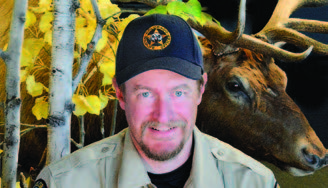
Aaron Berscheid is a district wildlife officer for Colorado Parks and Wildlife. Aaron covers the “wild” side of Northeast El Paso County, including Black Forest, Falcon, Peyton and Calhan. He also covers some of Elbert County, north of U.S. Highway 24 and south of State Highway 86, including the towns of Elbert, Kiowa, Ramah, Simla, Matheson and a small portion of the Limon area.
“Bear necessities” for keeping bears wild and alive
By Aaron Berscheid
District Wildlife Manager, CPW
It always seems to sneak up on us. Bear season, that is.
I’m not talking about hunting. I’m talking about springtime when the big, furry omnivores amble out of their dens and into our trash cans, if we aren’t practicing our “Bear Aware” strategies.
It’s funny that they always show up when we least expect them. It’s like encountering a flashing school zone speed limit for the first time after summer vacation. It catches you off guard. And when it’s a bear that surprises you, the encounter usually makes quite an impression.
So, let’s talk about the most common encounters that people will have with bears, and the most common reasons the bear encounter happened.
The absolute most common interaction that someone has with a bear is a mere sighting.
The majority of sightings are on security cameras and doorbell cameras. Assuming the bear did not damage anything around your house or property, these types of encounters are common-place wildlife encounters that you can have in the Black Forest area.
Let’s face it, bears are cool animals to look at and watch, and to have a personal sighting of a bear is an awesome experience.
However, if there is more to the story than just you seeing a bear, we need to examine the cause. If the bear tore into a trash can, or a bird feeder, or a barbecue grill or dog food left outside, then we as humans have a lot of responsibility for this behavior.
There are a lot of nuanced characteristics a bear has, but bear behavior really can be broken down into one description: Bears are a stomach with a nose.
When a bear is awake, it is looking for food. And like any creature, it is going to look for food in the easiest way possible. If humans haphazardly leave food sources available for bears, we can be creating a potentially deadly problem for a bear.
Once a bear is accustomed to human/easy food sources, it will associate humans with food. This leads to further interactions with humans and a higher likelihood of the bear getting more comfortable around humans.
Bears are naturally afraid of humans, and we want to keep it that way. Frankly, bears need it to stay that way. If bears become habituated to human food sources, they are ultimately the ones who suffer, even die.
A bear associating human occupied areas as fruitful hunting grounds: It is only a matter of time that they do something that cannot be tolerated. Behaviors that cannot be tolerated from a bear are aggression, entering into a dwelling or depredation on livestock.
What does this mean for a bear? Unfortunately, if a bear exhibits a behavior that is dangerous to human health and safety, CPW cannot relocate it.
What does this mean for humans? It is really up to us! We are the ones in control!
Be responsible!
- Only put your trash out the morning of pickup, as close to pickup as possible.
- Store BBQ grills in a locked location, or clean them after every use.
- Feed pets inside, and keep all stored pet food inside.
- Close and lock all doors and windows accessible to a bear (even ones accessible by decks).
- Do not leave any food sources in vehicles (bears are clever and will open car doors).
- Do not have bird feeders accessible to bears (bears love bird seed and sugar water)!
- PROTECT YOUR LIVESTOCK!!! ELECTRIC FENCING IS THE BEST PROTECTION! (this includes chickens, bee hives, goats, and other small livestock).
Lastly, report all bear encounters from sightings to anything else. This is the best way to avoid negative interactions with bears. I and CPW record all bear activity reported to us. This allows us to track bear activity almost in real time and allows us to identify problems before they become intolerable. This gives us a chance to intervene with bears that are becoming too habituated to humans before it’s too late.
In the coming months, I’ll share more stories as I write about wildlife issues in our community. Got a question, problem or column idea? Please email me at aaron.berscheid@state.co.us or call me at 719-227-5231.
I might even answer your question in a future installment of “Wildlife Matters.”




